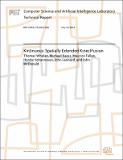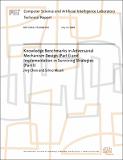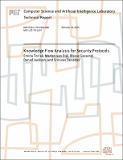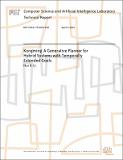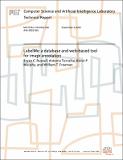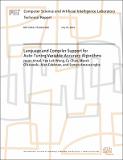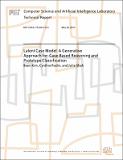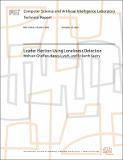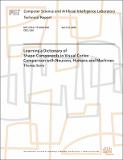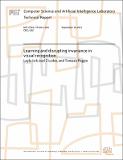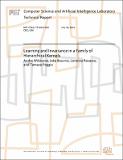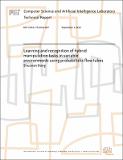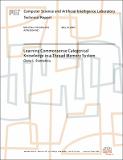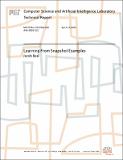Browsing CSAIL Digital Archive by Title
Now showing items 378-397 of 806
-
Kintinuous: Spatially Extended KinectFusion
(2012-07-19)In this paper we present an extension to the KinectFusion algorithm that permits dense mesh-based mapping of extended scale environments in real-time. This is achieved through (i) altering the original algorithm such that ... -
Knowledge Benchmarks in Adversarial Mechanism Design (Part I) and Implementation in Surviving Strategies (Part I)
(2008-07)We put forward new benchmarks and solution concepts for Adversarial Mechanism Design, as defined by [MV07.a], and we exemplify them in the case of truly combinatorial auctions.We benchmark the combined performance (the sum ... -
Knowledge Benchmarks in Adversarial Mechanism Design and Implementation in Surviving Strategies (Part I)
(2008-06)We put forward new benchmarks and solution concepts for Adversarial Mechanism Design, as defined by [MV07.a], and we exemplify them in the case of truly combinatorial auctions.We benchmark the combined performance (the sum ... -
Knowledge Flow Analysis for Security Protocols
(2005-10-19)Knowledge flow analysis offers a simple and flexible way to find flaws in security protocols. A protocol is described by a collection of rules constraining the propagation of knowledge amongst principals. Because this ... -
Kongming: A Generative Planner for Hybrid Systems with Temporally Extended Goals
(2010-04-09)Most unmanned missions in space and undersea are commanded by a "script" that specifies a sequence of discrete commands and continuous actions. Currently such scripts are mostly hand-generated by human operators. This ... -
LabelMe: a database and web-based tool for image annotation
(2005-09-08)Research in object detection and recognition in cluttered scenes requires large image collections with ground truth labels. The labels should provide information about the object classes present in each image, as well as ... -
Language and Compiler Support for Auto-Tuning Variable-Accuracy Algorithms
(2010-07-27)Approximating ideal program outputs is a common technique for solving computationally difficult problems, for adhering to processing or timing constraints, and for performance optimization in situations where perfect ... -
Latent Case Model: A Generative Approach for Case-Based Reasoning and Prototype Classification
(2014-05-26)We present a general framework for Bayesian case-based reasoning and prototype classification and clustering -- Latent Case Model (LCM). LCM learns the most representative prototype observations of a dataset by performing ... -
Latent-Dynamic Discriminative Models for Continuous Gesture Recognition
(2007-01-07)Many problems in vision involve the prediction of a class label for each frame in an unsegmented sequence. In this paper we develop a discriminative framework for simultaneous sequence segmentation and labeling which can ... -
Leader Election Using Loneliness Detection
(2011-10-12)We consider the problem of leader election (LE) in single-hop radio networks with synchronized time slots for transmitting and receiving messages. We assume that the actual number n of processes is unknown, while the size ... -
LEAP Scratchpads: Automatic Memory and Cache Management for Reconfigurable Logic [Extended Version]
(2010-11-23)Developers accelerating applications on FPGAs or other reconfigurable logic have nothing but raw memory devices in their standard toolkits. Each project typically includes tedious development of single-use memory management. ... -
Learning a Dictionary of Shape-Components in Visual Cortex: Comparison with Neurons, Humans and Machines
(2006-04-25)In this thesis, I describe a quantitative model that accounts for the circuits and computations of the feedforward path of the ventral stream of visual cortex. This model is consistent with a general theory of visual ... -
Learning and disrupting invariance in visual recognition
(2011-09-10)Learning by temporal association rules such as Foldiak's trace rule is an attractive hypothesis that explains the development of invariance in visual recognition. Consistent with these rules, several recent experiments ... -
Learning and Invariance in a Family of Hierarchical Kernels
(2010-07-30)Understanding invariance and discrimination properties of hierarchical models is arguably the key to understanding how and why such models, of which the the mammalian visual system is one instance, can lead to good ... -
Learning and recognition of hybrid manipulation tasks in variable environments using probabilistic flow tubes
(2012-08-23)Robots can act as proxies for human operators in environments where a human operator is not present or cannot directly perform a task, such as in dangerous or remote situations. Teleoperation is a common interface for ... -
Learning by Learning To Communicate
(2007-08-23)Human intelligence is a product of cooperation among many different specialists. Much of this cooperation must be learned, but we do not yet have a mechanism that explains how this might happen for the "high-level" agile ... -
Learning Commonsense Categorical Knowledge in a Thread Memory System
(2004-05-18)If we are to understand how we can build machines capable of broadpurpose learning and reasoning, we must first aim to build systemsthat can represent, acquire, and reason about the kinds of commonsenseknowledge that we ... -
Learning complex cell invariance from natural videos: A plausibility proof
(2007-12-26)One of the most striking feature of the cortex is its ability to wire itself. Understanding how the visual cortex wires up through development and how visual experience refines connections into adulthood is a key question ... -
Learning From Snapshot Examples
(2005-04-13)Examples are a powerful tool for teaching both humans and computers.In order to learn from examples, however, a student must first extractthe examples from its stream of perception. Snapshot learning is ageneral approach ... -
Learning Generic Invariances in Object Recognition: Translation and Scale
(2010-12-30)Invariance to various transformations is key to object recognition but existing definitions of invariance are somewhat confusing while discussions of invariance are often confused. In this report, we provide an operational ...

